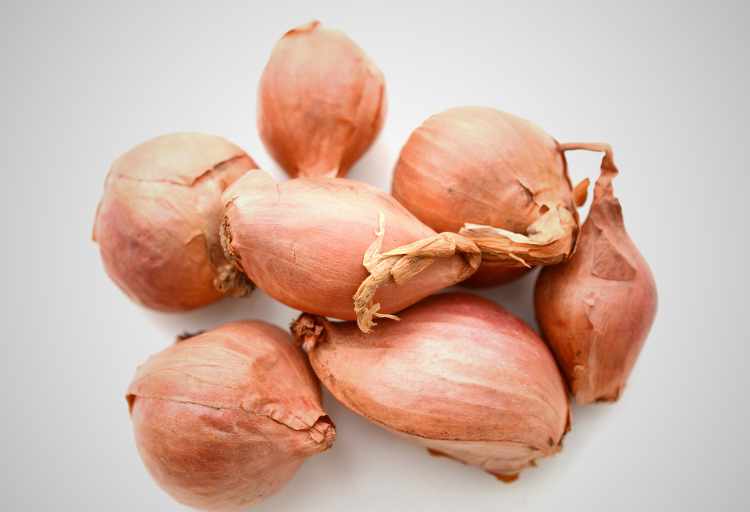Shallots Vs Red Onion
Are you tired of using the same old onions in your cooking? If so, it’s time to switch things up and explore the world of shallots and red onions. These flavorful ingredients may look similar at first glance, but they each bring their own unique qualities to the table.
In this article, we’ll compare shallots and red onions in terms of flavor profiles, culinary uses, nutritional benefits, appearance and texture differences, storage and shelf life, as well as availability and cost. By understanding the distinct characteristics of each ingredient, you’ll be able to make informed decisions about which one is best suited for your dishes.
So get ready to elevate your cooking game with shallots or red onions – it’s time to discover a whole new world of flavors!

Flavor Profiles of Shallots and Red Onions
When you bite into a dish seasoned with shallots, their delicate and sweet flavor dances on your taste buds like a graceful waltz.
Shallots have a milder and sweeter taste compared to red onions, making them perfect for dishes that require a subtle onion flavor. They add depth without overpowering other ingredients.
Red onions, on the other hand, have a stronger and more pungent flavor. They can be slightly spicy and bring boldness to dishes. Both shallots and red onions can be used in various cooking techniques such as sautéing, caramelizing, or pickling.
Shallots are often preferred for recipes that require gentle cooking methods like vinaigrettes or sauces because they don’t lose their delicate flavor easily.
Red onions are great for grilling or roasting due to their robust taste that holds up well under high heat.
Culinary Uses of Shallots and Red Onions
For those who love adding a touch of sweetness and depth to their dishes, shallots and red onions are versatile ingredients that bring a burst of flavor to any culinary creation. Here are three ways you can use these flavorful ingredients in your cooking:
- Sautéed: Shallots and red onions can be thinly sliced and sautéed in butter or oil until they turn translucent and slightly caramelized. This adds a rich, sweet flavor to sauces, stir-fries, or roasted vegetables.
- Raw: Both shallots and red onions can be used raw in salads, salsas, or dressings to add a crisp texture and a mild onion flavor. They provide a refreshing contrast to other ingredients.
- Culinary Pairings: Shallots work especially well with seafood dishes such as scallops or shrimp due to their delicate flavor. Red onions pair nicely with grilled meats like burgers or steaks, as they add a tangy kick.
In addition to their culinary pairings, both shallots and red onions offer health benefits such as being low in calories and containing antioxidants that support immune function. So next time you’re looking for an ingredient that enhances both taste and health, reach for shallots or red onions!
Nutritional Benefits of Shallots and Red Onions
Indulging in the flavorful delights of shallots and red onions not only tantalizes your taste buds but also nourishes your body with a plethora of nutritional benefits.
Both shallots and red onions offer unique health benefits that make them valuable additions to your culinary repertoire.
When it comes to preparation methods, both shallots and red onions can be used raw or cooked. Shallots are often sliced thinly and added to salads or sautéed for a milder flavor. Red onions, on the other hand, can be sliced into rings for sandwiches or diced for salsas and relishes.
In terms of health benefits, both shallots and red onions are rich in antioxidants that help fight inflammation in the body. They also contain compounds that may lower blood pressure and cholesterol levels. Additionally, they are a good source of vitamins C and B6, which support immune function and brain health.
So go ahead and enjoy the delicious flavors while reaping the numerous health benefits of shallots and red onions in your meals!
Appearance and Texture Differences
Get ready to explore the unique characteristics of shallots and red onions, from their distinct appearances to the delightful textures they bring to your dishes.
When it comes to appearance, shallots have a more elongated shape compared to red onions, which are rounder in form. Shallots also have a reddish-brown skin color, while red onions feature a vibrant purple hue that adds visual appeal to any dish.
In terms of texture, shallots have a milder and sweeter flavor profile than red onions. They’re softer and less crunchy when raw, making them perfect for salads or dressings.
On the other hand, red onions offer a stronger taste and firmer texture when cooked, providing a satisfying crunch in stir-fries or roasted dishes.
Overall, these appearance differences and texture variations make both shallots and red onions versatile ingredients that can elevate the flavors of your culinary creations.
Storage and Shelf Life
When it comes to storage and shelf life, shallots have a longer lifespan compared to red onions. You should store shallots in a cool and dry place to ensure they last longer.
On the other hand, red onions have a shorter shelf life and should be stored in a cool and dark place to keep them fresh for as long as possible.
Shallots – Longer Shelf Life, Store in Cool, Dry Place
Storing shallots in a cool, dry place ensures their longer shelf life, allowing you to savor their exquisite flavor for weeks.
Compared to red onions, shallots have a superior shelf life due to their lower water content. This means that they can be stored for a longer period without sprouting or rotting.
To keep your shallots fresh and flavorful, make sure to store them in a well-ventilated area away from direct sunlight and moisture.
A pantry or cellar is an ideal location. Remember to avoid storing them near potatoes as they release gases that can cause shallots to spoil faster.
Red Onions – Shorter Shelf Life, Store in a Cool, Dark Place
For optimal freshness, keep your red onions in a cool, dark spot to extend their shelf life. Unlike shallots, which have a longer shelf life and can be stored in a cool, dry place, red onions are more delicate and require specific conditions for preservation.
Red onions have a shorter shelf life due to their higher water content compared to shallots. To maintain their flavor and texture, it’s important to store them properly.
The cool temperature helps slow down the process of sprouting or rotting, while the darkness prevents them from turning green or developing bitter flavors.
When it comes to cooking techniques, red onions are known for their milder taste compared to shallots. They add a sweet and slightly spicy flavor to dishes such as salads, sandwiches, salsas, and stir-fries.
Availability and Cost
Although red onions and shallots are readily available in most grocery stores, shallots tend to be more expensive due to their limited availability. If you find yourself comparing the cost between these two options, here are three things to keep in mind:
- Shallots, with their elongated shape and reddish-brown skin, exude an exotic allure that can elevate your culinary creations. However, this uniqueness comes at a price.
- Red onions, on the other hand, boast a vibrant hue and a sharp flavor that adds depth to salads or roasted dishes. They offer a more budget-friendly alternative without compromising on taste.
- Availability may vary depending on where you live. While red onions are typically abundant year-round in most regions, shallots might be harder to come by or limited to specialty markets.
Ultimately, the choice between shallots and red onions boils down to personal preference and the budget you’re working with.
Shallots or Red Onions
In the end, it all comes down to your personal taste and budget – choose the ingredient that’ll make your dishes sing and your wallet smile.
When it comes to cooking, both shallots and red onions have their own unique qualities. Shallots are known for their delicate flavor and mild sweetness, making them perfect for dishes where you want a subtle onion flavor without overpowering other ingredients.
On the other hand, red onions have a bolder and slightly spicier taste, which can add depth and complexity to various recipes. In terms of versatility, red onions take the lead as they can be used in a wide range of dishes such as salads, salsas, stir-fries, and even pickling.
Ultimately, whether you choose shallots or red onions depends on your preference and the specific flavors you want to achieve in your culinary creations.
Conclusion
In conclusion, when it comes to choosing between shallots and red onions, both have their own unique flavors and culinary uses.
Shallots offer a milder and sweeter taste, making them perfect for dressings and sauces. On the other hand, red onions provide a stronger and more pungent flavor that pairs well with grilled dishes.
In terms of nutrition, both are low in calories but contain beneficial antioxidants.
Ultimately, the choice between shallots or red onions depends on personal preference and the specific dish you’re preparing.
